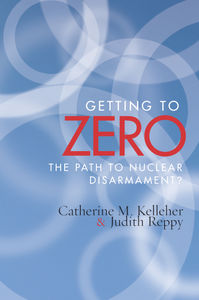The Path to Nuclear Disarmament
ANDALO (Trento) 2009
Edited by Catherine M. Kelleher, Judith Reppy
Published by Stanford Security Studies, 2011
432 pages
ISBN 9780804777025

President Obama’s steps toward nuclear disarmament have so far been “more expectable than revolutionary, but they do emphasize renewed American leadership,” according to a new book co-edited by long-time ISODARCO participants Catherine McArdle Kelleher of Brown University and the University of Maryland, and Judith V. Reppy of Cornell University. Getting to Zero: The Path to Nuclear Disarmament (Stanford University Press, 2011) takes on the much-debated goal of nuclear zero – exploring the serious policy questions raised by nuclear disarmament and suggesting practical steps for the nuclear weapon states to take to achieve it. The book documents the successes and failures of six decades of attempts to control nuclear weapons proliferation and asks the urgent questions about what else world leaders, politicians, non-government organizations, and scholars must address if nuclear zero is to be a real policy goal.
Published in hard and paperback versions and in e-book format, the collection emerged from a series of conversations and exchanges that took place under the Carnegie Corporation project “Dialogue among Americans, Russians, and Europeans” (DARE), which in turn influenced several ISODARCO programs led by Reppy and Kelleher. To cite only a few of the familiar ISODARCO lecturers included in Getting to Zero, there are articles by Alexei Arbatov, Nadia Arbatova, Marco DeAndreis, Matthew Evangelista, Venance Journe, and Jeffrey Lewis, as well as by Kelleher and Reppy themselves.
Introduction
Catherine McArdle Kelleher
How We Got to Where We Are
The Vision of a World Free of Nuclear Weapons
David Holloway
Advocacy for Nuclear Disarmament: A Global Revival?
Randy Rydell
Is a World without Nuclear Weapons Attainable? Comparative Perspectives on Goals and Prospects
Golz Neuneck.
Past Decisions, Future Perspectives
The U.S. Nuclear Arsenal and Zero: Sizing and Planning for Use-Past, Present, and Future
Lynn Eden
Nuclear Deterrence, Disarmament, and Nonproliferation
Alexei G. Arbatv
British Thinking on Nuclear Weapons
Ian Anthony
France’s Nuclear Stance: Independence, Unilateralism, and Adaptation
Venance Journé
Challenges for U.S.-China Strategic Stability in the Obama Administration
Jeffrey Lewis
Regional Consequences
Europe, Nuclear Disarmament, and Nonproliferation: What Next?
Nadia Alexandrova-Arbatova
Israel’s Nuclear Future: Iran, Opacity, and the Vision of Global Zero
Avner Cohen
Iran Policy on the Way to Zero
Jill Marie Lewis with Laicie Olson
India and Nuclear Zero
Waheguru Pai Singh Sidhu
Issues and Constraints
Fissile Materials and Disarmament: Long-term Goals, Short-term
Steps James M. Acton
Nuclear Zero at the Weapons Laboratories
Judith Reppy
Is the Civil Nuclear Industry Relevant to Nuclear Disarmament?
Marco De Andreis and Simon Moore
Nuclear Abolition or Nuclear Umbrella? Choices and Contradictions in U.S. Proposals
Matthew Evangelista
American Conventional Superiority: The Balancing Act
Dennis M. Gormley
What Next?
Steps toward a World Free of Nuclear Weapons
David Holloway
Practical Steps toward Nuclear Zero
Peler Dombrawski
Index

